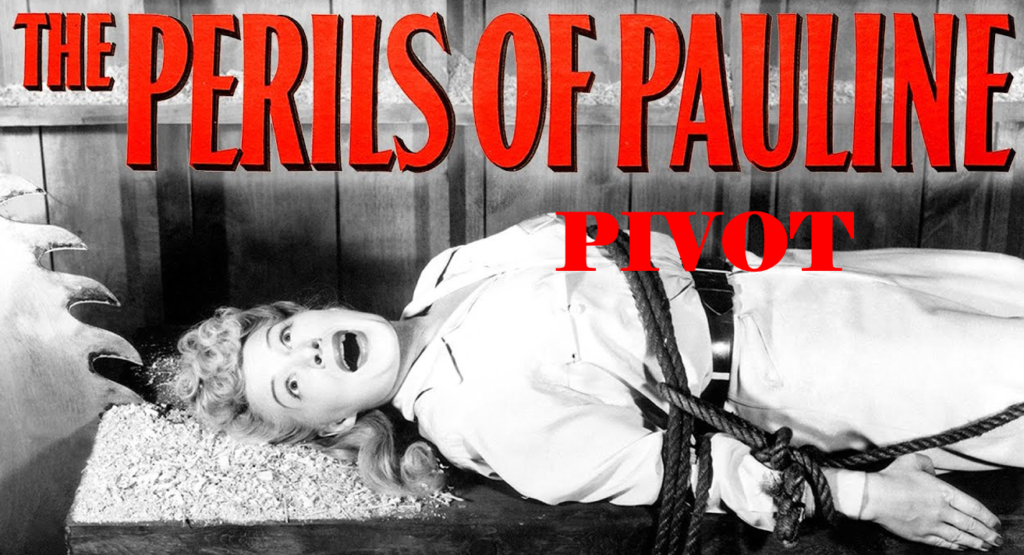
Photo: YouTube
By Michael O’Neill
The Perils of Pauline is a remake of an early 20th-century film serial about and wealthy young woman narrowly avoiding death in a series of adventures before she marries and inherits a boat-load of money. The Perils of Pauline Pivot is a similar tale about the pitfalls of premature policy pivots.
Fed Chair Jerome Powell and his colleagues on the Federal Open Market Committee finally acquiesced to the demands of rising US inflation on March 16 and raised rates by 50 basis points. It was the largest rate hike since 2000, and they followed that move with another 50 bp hike in May.
Unfortunately, the hikes were not getting the job done. Inflation continued to ratchet higher, rising from 7.5% y/y in January to 8.6% in May.
Those numbers came out five days before the Fed’s June meeting, and policymakers were spooked.
They responded with an outsized 75 bp bump in June and another one at the end of July. The latter hike was a relief to some traders after the Bank of Canada showed the Fed what a jumbo rate hike looked like when the BoC raised rates by 100 bps on July 13.
When the Fed failed to match the BoC, some analysts speculated that the Fed would pivot and look to cut rates in January 2023. The idea got traction helping the S&P 500 index rally from 3970 on July 27 to 4170 on August 4. A steep drop in the US 10-year yield from 3.04% on July 20 to 2.51% August 2 also greased the skids.
Some astute analysts believe that the door is wide open to Fed easing at the beginning of 2023. A JP Morgan economist suggests that softer labour markets and slowing growth would prompt the Fed to pivot in the second half.
An analyst at Morningstar predicts the Fed will cut rates in 2023 because inflation will be falling to the Fed’s 2.0% target, and an ailing economy will need the stimulus.
It has been a scorching summer, and pivot chatter may be a sign of heat stroke.

Photo: HDClipart.com
If taming inflation was so easy, Turkey wouldn’t suffer from a 144.6% y/y inflation problem. In fact, the astronomical inflation level is largely due to President Erdogan ordering the Central Bank of Turkey to cut interest rates. Clearly cutting interest rates too soon exacerbates rather than calms overheated prices.
Bill Dudley, the former President of the New York Fed, believes the market reaction to the idea the Fed won’t raise rates much further is “wishful thinking.” He noted that Mr Powell continued to reference June “dot-plot” projections which show fed funds 50 bps higher than where markets expect.
Cleveland Fed President Loretta Mester believes the Fed will continue raising rates in 2023, suggesting going above 4.0% would be appropriate. She wants to see several months of inflation declines, before the Fed can ease up on rates and her opinion counts as she is a voting member of the FOMC.
Mr Powell did not indicate he was considering pivoting during his July 27post-FOMC press conference. Far from it.
He stressed the Fed’s commitment to returning inflation to its 2% target. He pointed out that ongoing increases in the fed funds rate would be necessary since demand appears to remain strong, supply constraints have been larger and longer lasting than anticipated, and price pressures are evident across a broad range of goods and services.
Those are the hardly the words of a guy planning to chop rates.
No one is talking about a Bank of Canada pivot, but perhaps it should be part of the discussion. Bank of Montreal’s Chief Economist Douglas Porter pointed out signs that inflation may be at an inflection point. He pointed out falling commodity prices, highlighting steep drops in oil, gas, and grain. He also took note of lower freight rates, rising retail inventories, and a cooling housing market.
If Canadian inflation has peaked, additional Bank of Canada rate hikes may be unnecessary. That would penalize the Canadian dollar as rising US interest rates would make the greenback far more attractive to investors than the Loonie.
Falling commodity prices may be good news on the inflation front but bad news for Canadian government revenues and the Canadian currency.
West Texas Intermediate (WTI) is probing twenty-two month support in the $88.00/barrel area. A sustained move below that level suggests further losses to $60.00/b.
The BoC‘s 100 bp rate hike more than offset lower crude prices but that will not last if WTI oil drops through the floor.
Persistent and widespread US inflation and hawkish comments from Fed policymakers suggest that a talk of an early 2023 Fed pivot is premature.
The risk of rising US interest rates, sluggish Canadian economic growth and falling oil prices, will limit USDCAD downside to the 1.2500 area.
Pauline never saw perils like the financial timebombs littering the landscape.





